新课改单元整体教学设计人教版七年级上册Unit 3 Is this your pencil?(表格式 4课时)
文档属性
| 名称 | 新课改单元整体教学设计人教版七年级上册Unit 3 Is this your pencil?(表格式 4课时) |
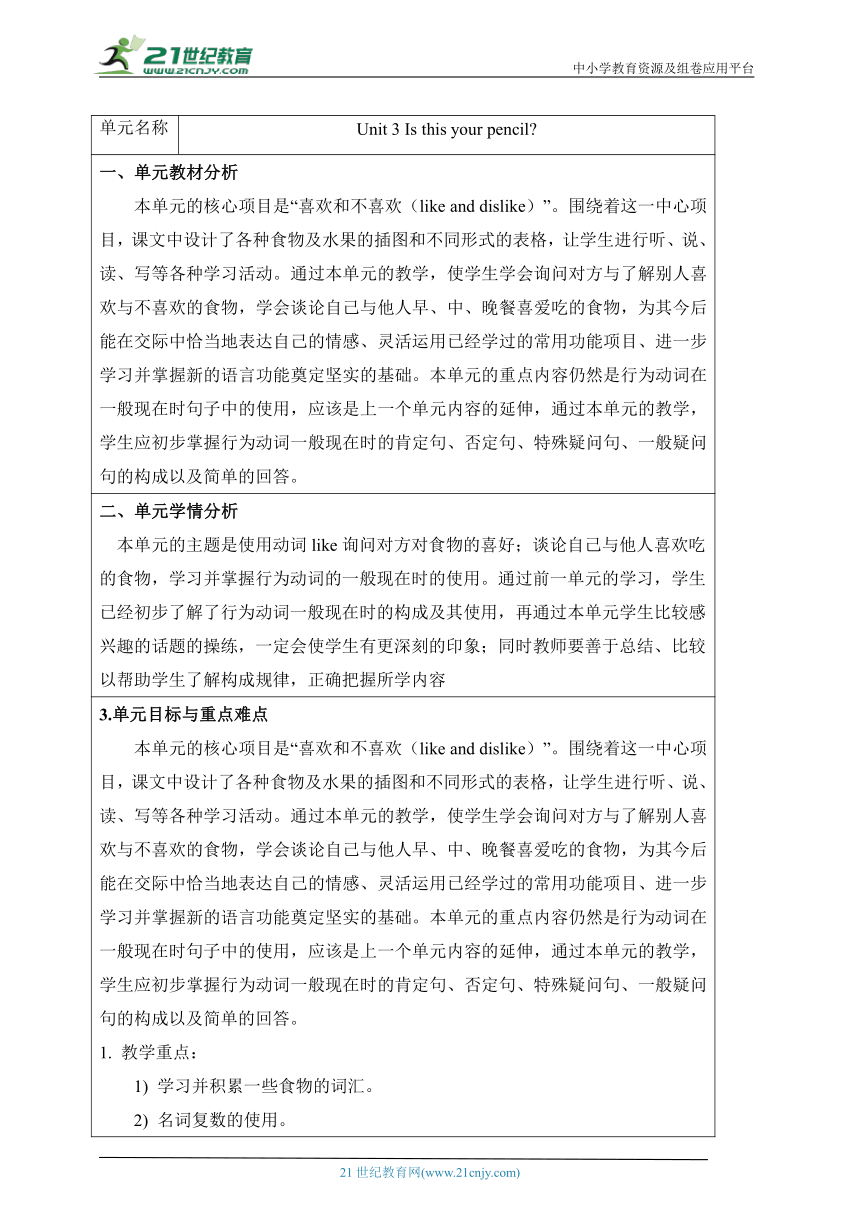
|
|
| 格式 | docx | ||
| 文件大小 | 68.9KB | ||
| 资源类型 | 试卷 | ||
| 版本资源 | 人教新目标(Go for it)版 | ||
| 科目 | 英语 | ||
| 更新时间 | 2023-12-21 14:29:49 | ||
图片预览

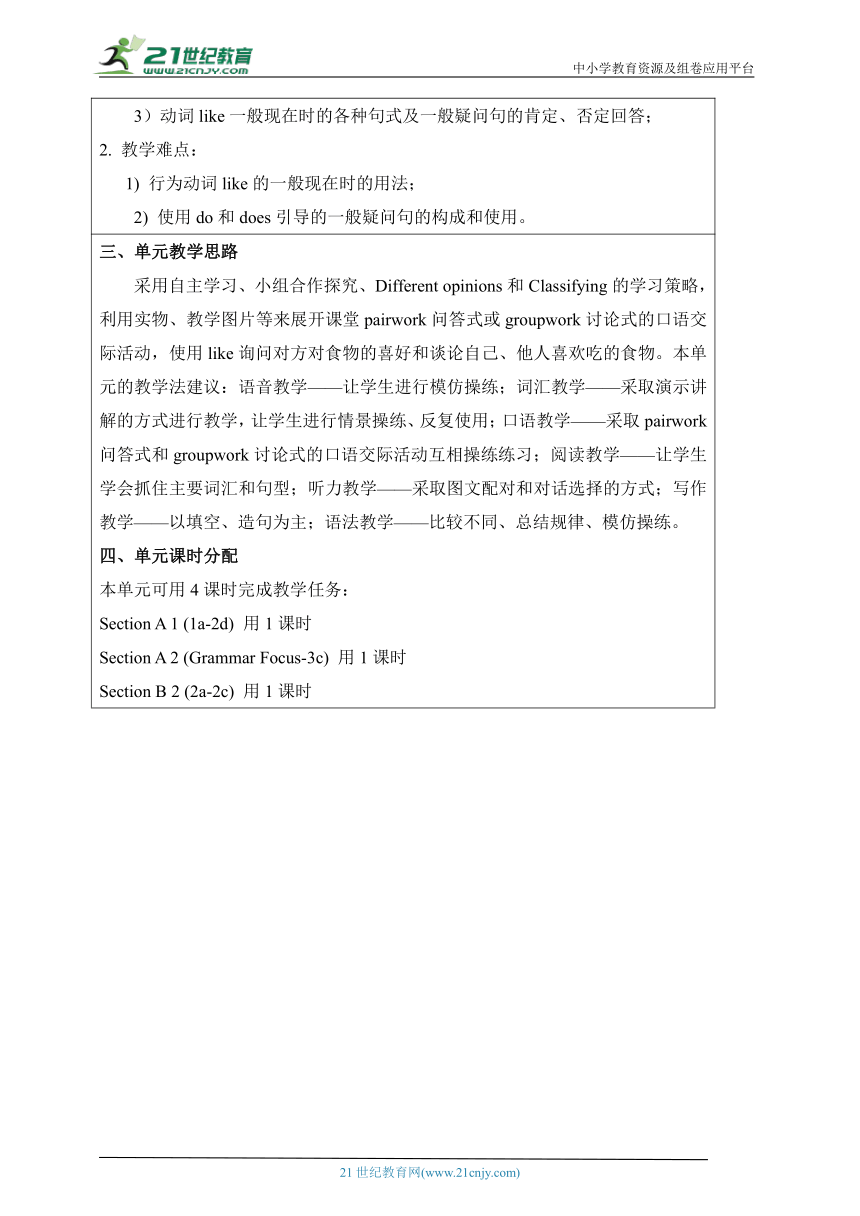
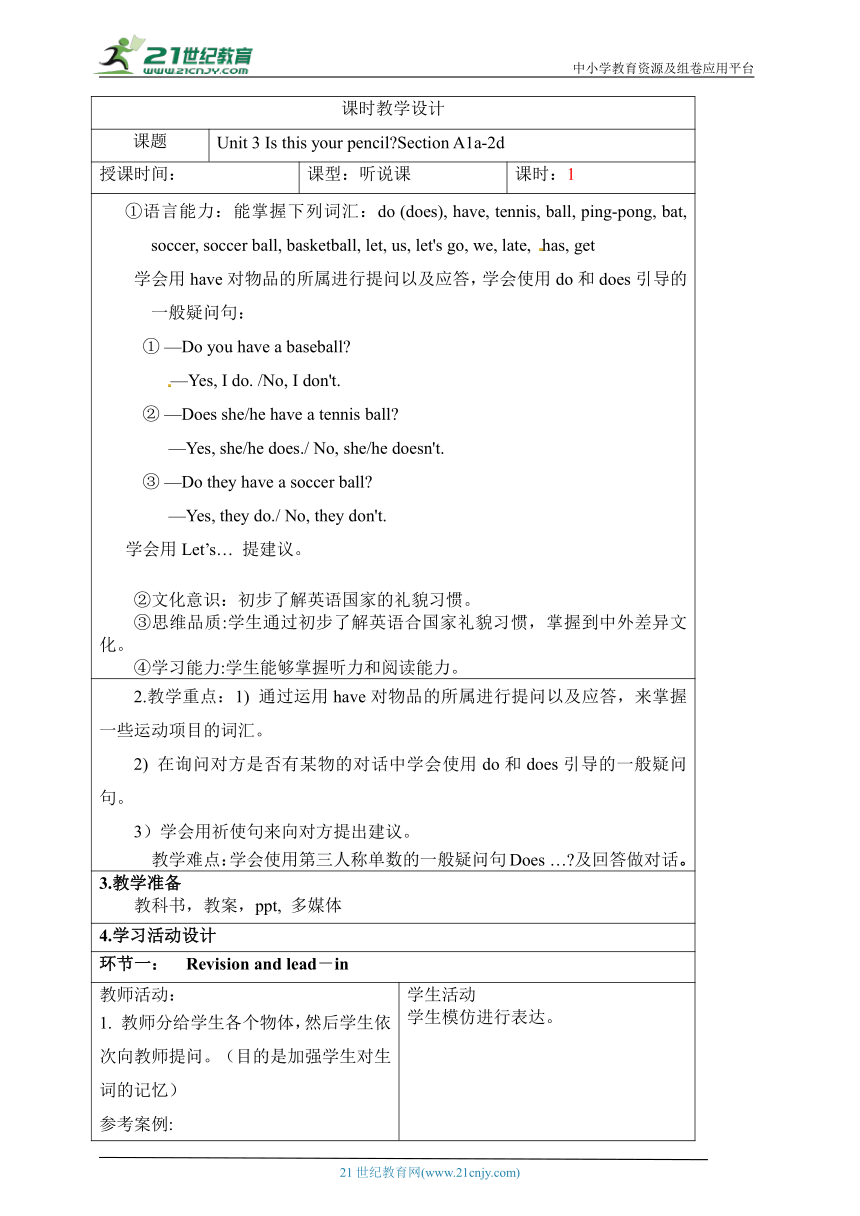
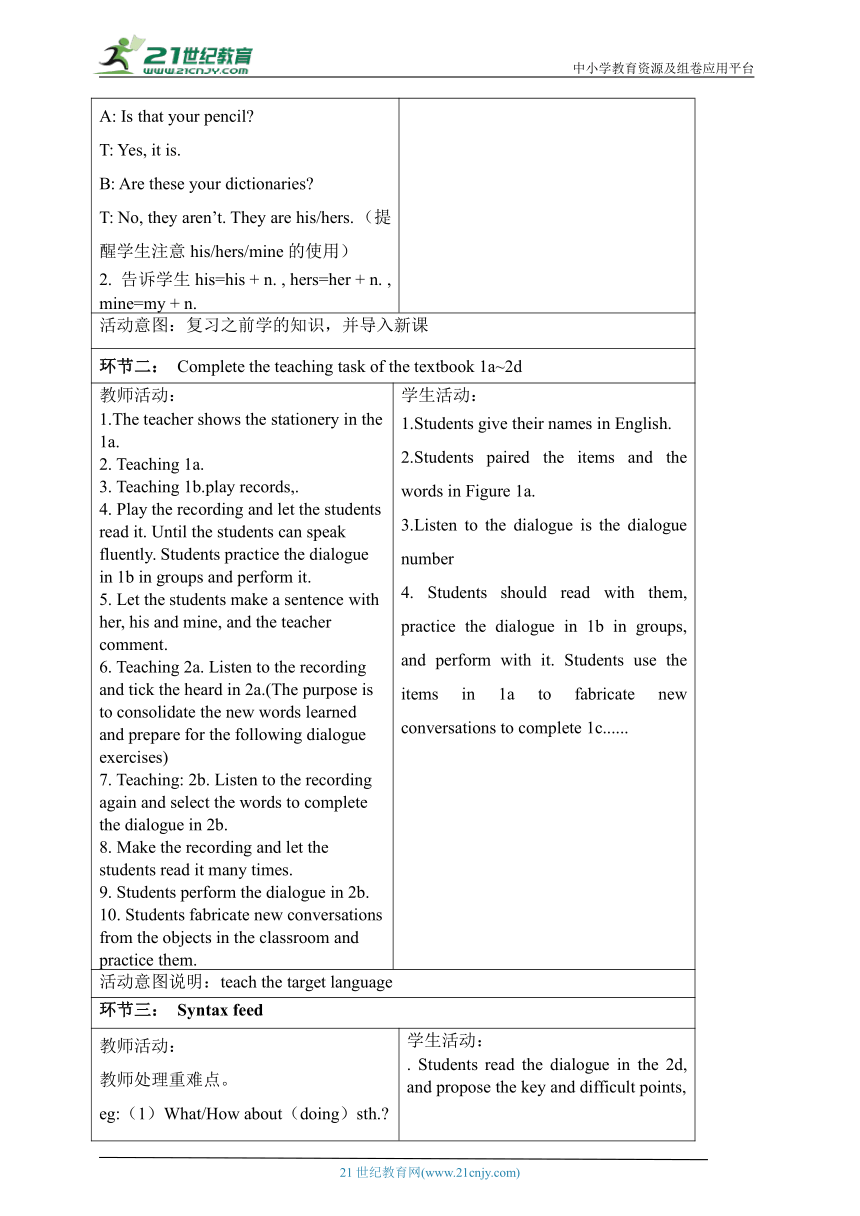
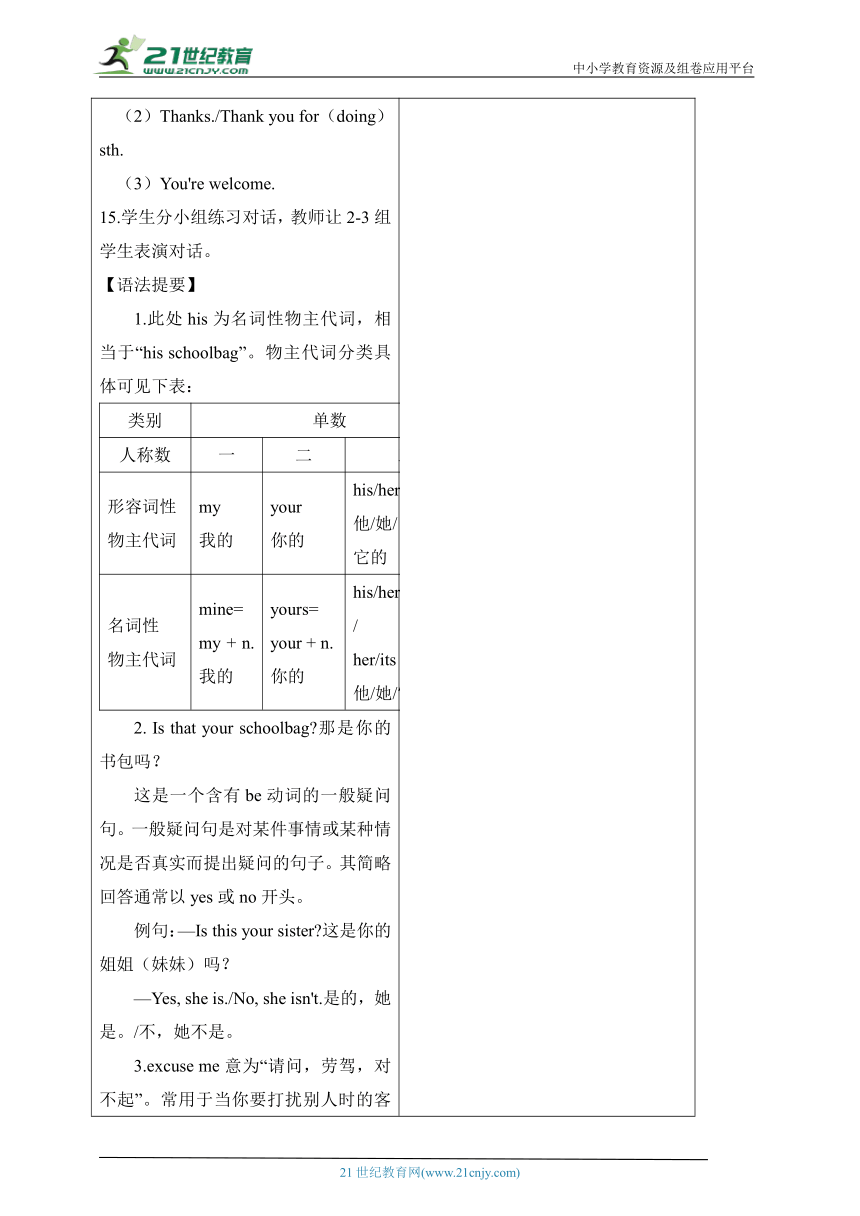
文档简介
单元名称 Unit 3 Is this your pencil
一、单元教材分析 本单元的核心项目是“喜欢和不喜欢(like and dislike)”。围绕着这一中心项目,课文中设计了各种食物及水果的插图和不同形式的表格,让学生进行听、说、读、写等各种学习活动。通过本单元的教学,使学生学会询问对方与了解别人喜欢与不喜欢的食物,学会谈论自己与他人早、中、晚餐喜爱吃的食物,为其今后能在交际中恰当地表达自己的情感、灵活运用已经学过的常用功能项目、进一步学习并掌握新的语言功能奠定坚实的基础。本单元的重点内容仍然是行为动词在一般现在时句子中的使用,应该是上一个单元内容的延伸,通过本单元的教学,学生应初步掌握行为动词一般现在时的肯定句、否定句、特殊疑问句、一般疑问句的构成以及简单的回答。
二、单元学情分析 本单元的主题是使用动词like询问对方对食物的喜好;谈论自己与他人喜欢吃的食物,学习并掌握行为动词的一般现在时的使用。通过前一单元的学习,学生已经初步了解了行为动词一般现在时的构成及其使用,再通过本单元学生比较感兴趣的话题的操练,一定会使学生有更深刻的印象;同时教师要善于总结、比较以帮助学生了解构成规律,正确把握所学内容
3.单元目标与重点难点 本单元的核心项目是“喜欢和不喜欢(like and dislike)”。围绕着这一中心项目,课文中设计了各种食物及水果的插图和不同形式的表格,让学生进行听、说、读、写等各种学习活动。通过本单元的教学,使学生学会询问对方与了解别人喜欢与不喜欢的食物,学会谈论自己与他人早、中、晚餐喜爱吃的食物,为其今后能在交际中恰当地表达自己的情感、灵活运用已经学过的常用功能项目、进一步学习并掌握新的语言功能奠定坚实的基础。本单元的重点内容仍然是行为动词在一般现在时句子中的使用,应该是上一个单元内容的延伸,通过本单元的教学,学生应初步掌握行为动词一般现在时的肯定句、否定句、特殊疑问句、一般疑问句的构成以及简单的回答。 1. 教学重点: 1) 学习并积累一些食物的词汇。 2) 名词复数的使用。 3)动词like一般现在时的各种句式及一般疑问句的肯定、否定回答; 2. 教学难点: 1) 行为动词like的一般现在时的用法; 2) 使用do和does引导的一般疑问句的构成和使用。
三、单元教学思路 采用自主学习、小组合作探究、Different opinions和Classifying的学习策略,利用实物、教学图片等来展开课堂pairwork问答式或groupwork讨论式的口语交际活动,使用like询问对方对食物的喜好和谈论自己、他人喜欢吃的食物。本单元的教学法建议:语音教学——让学生进行模仿操练;词汇教学——采取演示讲解的方式进行教学,让学生进行情景操练、反复使用;口语教学——采取pairwork问答式和groupwork讨论式的口语交际活动互相操练练习;阅读教学——让学生学会抓住主要词汇和句型;听力教学——采取图文配对和对话选择的方式;写作教学——以填空、造句为主;语法教学——比较不同、总结规律、模仿操练。 四、单元课时分配 本单元可用4课时完成教学任务: Section A 1 (1a-2d) 用1课时 Section A 2 (Grammar Focus-3c) 用1课时 Section B 2 (2a-2c) 用1课时
中小学教育资源及组卷应用平台
21世纪教育网 www.21cnjy.com 精品试卷·第 2 页 (共 2 页)
21世纪教育网(www.21cnjy.com)
课时教学设计
课题 Unit 3 Is this your pencil Section A1a-2d
授课时间: 课型:听说课 课时:1
①语言能力:能掌握下列词汇:do (does), have, tennis, ball, ping-pong, bat, soccer, soccer ball, basketball, let, us, let's go, we, late, has, get 学会用have对物品的所属进行提问以及应答,学会使用do和does引导的一般疑问句: ① —Do you have a baseball —Yes, I do. /No, I don't. ② —Does she/he have a tennis ball —Yes, she/he does./ No, she/he doesn't. ③ —Do they have a soccer ball —Yes, they do./ No, they don't. 学会用Let’s… 提建议。 ②文化意识:初步了解英语国家的礼貌习惯。 ③思维品质:学生通过初步了解英语合国家礼貌习惯,掌握到中外差异文化。 ④学习能力:学生能够掌握听力和阅读能力。
2.教学重点:1) 通过运用have对物品的所属进行提问以及应答,来掌握一些运动项目的词汇。 2) 在询问对方是否有某物的对话中学会使用do和does引导的一般疑问句。 3)学会用祈使句来向对方提出建议。 教学难点:学会使用第三人称单数的一般疑问句Does … 及回答做对话。
3.教学准备 教科书,教案,ppt, 多媒体
4.学习活动设计
环节一: Revision and lead-in
教师活动: 1. 教师分给学生各个物体,然后学生依次向教师提问。(目的是加强学生对生词的记忆) 参考案例: A: Is that your pencil T: Yes, it is. B: Are these your dictionaries T: No, they aren’t. They are his/hers. (提醒学生注意his/hers/mine的使用) 2. 告诉学生his=his + n. , hers=her + n. , mine=my + n. 学生活动 学生模仿进行表达。
活动意图:复习之前学的知识,并导入新课
环节二: Complete the teaching task of the textbook 1a~2d
教师活动: 1.The teacher shows the stationery in the 1a. 2. Teaching 1a. 3. Teaching 1b.play records,. 4. Play the recording and let the students read it. Until the students can speak fluently. Students practice the dialogue in 1b in groups and perform it. 5. Let the students make a sentence with her, his and mine, and the teacher comment. 6. Teaching 2a. Listen to the recording and tick the heard in 2a.(The purpose is to consolidate the new words learned and prepare for the following dialogue exercises) 7. Teaching: 2b. Listen to the recording again and select the words to complete the dialogue in 2b. 8. Make the recording and let the students read it many times. 9. Students perform the dialogue in 2b. 10. Students fabricate new conversations from the objects in the classroom and practice them. 学生活动: 1.Students give their names in English. 2.Students paired the items and the words in Figure 1a. 3.Listen to the dialogue is the dialogue number 4. Students should read with them, practice the dialogue in 1b in groups, and perform with it. Students use the items in 1a to fabricate new conversations to complete 1c......
活动意图说明:teach the target language
环节三: Syntax feed
教师活动: 教师处理重难点。 eg:(1)What/How about(doing)sth. (2)Thanks./Thank you for(doing)sth. (3)You're welcome. 15.学生分小组练习对话,教师让2-3组学生表演对话。 【语法提要】 1.此处his为名词性物主代词,相当于“his schoolbag”。物主代词分类具体可见下表: 类别单数复数人称数一二三一二三形容词性 物主代词my 我的your 你的his/her/its 他/她/ 它的our 我们的your 你们的their 他/她/ 它们的名词性 物主代词mine= my + n. 我的yours= your + n. 你的his/hers/its=his/ her/its + n. 他/她/它的ours=our + n. 我们的yours= your + n. 你们的theirs=their + n. 他/她/他/她/它们的
2. Is that your schoolbag 那是你的书包吗? 这是一个含有be动词的一般疑问句。一般疑问句是对某件事情或某种情况是否真实而提出疑问的句子。其简略回答通常以yes或no开头。 例句:—Is this your sister 这是你的姐姐(妹妹)吗? —Yes, she is./No, she isn't.是的,她是。/不,她不是。 3.excuse me意为“请问,劳驾,对不起”。常用于当你要打扰别人时的客套用语。主要用于以下场合: (1)打搅别人、请人帮忙、询问情况(如问路、问姓名等)。 例句:Excuse me, could you please tell me how to get to People's Park 劳驾,请问你能告诉我怎么去人民公园吗 (2)打断别人的话或正在做的事。 例句:Excuse me,I have to interrupt you.对不起,我必须要打断一下。 (3)征求对方的许可。 例句:Excuse me, Mr. Green. May I ask you some questions 打扰一下,格林先生,我可以问你几个问题吗? 4.what about意为“如何;好吗;怎么样”,用于非正式场合中对所谈话题进行反问,或询问对方相同的情况,以避免重复;也可用于询问消息、提出建议、向对方征求意见。后可接名词、代词或动名词,与how about同义。 例句:What/How about a cup of tea 来杯茶好吗? —What about going to the park 去公园怎么样? —That sounds great.听起来不错。 学生活动: . Students read the dialogue in the 2d, and propose the key and difficult points,
环节四 :Learn to practice
( A )1.—Is this your dictionary —_________. Yes, it is B. No, it is C. I have a dictionary D. Thank you ( C )2.—The camera(相机) in your hand(手里)is nice. Is it________? —Yes, but I'll give(给)it to my friend Lily, as______ birthday present(作为生日礼物). you;her B. your;hers C. yours;her D. you;hers ( B )3.—_______.Which is the way to the hospital —Sorry, I'm new here. Sorry B. Excuse me C. Hello D. How do you dple with the balls.
活动意图: Improve the Ss's studying ability.
Homework 1. 复习记忆本课所学的生词。 2. 编写三个问答句:
Black board design : Unit 3 Is this your pencil Section A1a-2d Are these your pencils , new words
7.教学反思与改进
课时教学设计
课题名称 Unit 3 Is this your pencil Section A GF-3c
授课时间: 课型:语法课 课时:2
教学重难点 1. 通过情境体验,能够复习含有be动词的一般疑问句的结构和答语。 2. 通过情境体验,能够区分形容词性物主代词和名词性物主代词,并能理解名词性物主代词在真实情境中表所属关系的用法。
二、教学准备 Textbook, a recorder, a pen
三、学习活动设计
环节一: Lead-in
教师活动: 1.Greeting. 2.T plays a video to know about the theme of this class—Possessive pronoun. 3. T shows a picture of the LOST AND FOUND and asks students to find the owners of these things by asking some questions. 学生活动: 观看歌曲视频并了解本节课语法重点—物主代词。 观察失物招领处的物品,思考通过问什么样的问题能找到失主。
设计意图:利用动画,引入本科主题—物主代词,引导学生跟唱,激发学生学习兴趣,活跃课堂气氛。 通过情境设置导入语法学习。
环节二:Presentation
教师活动: 2.T asks students to look at the picture and try to complete the blanks and answer the questions.(T changes the distance and quantity to emphasize the change of demonstrative pronouns and singular and plural nouns.) 3.T shows sentences and leads students to pay attention to the structures. 4.T shows some notebooks with different names and asks students to complete the sentences according to the tips. 5.T shows the form of possessive pronouns and asks the students to fill in the blanks with appropriate words. Then show the grammar summary and ask the students to fill in the blanks. 学生活动: 观察图片,根据情境补全句子内容。 注意观察句型结构并做好笔记。 观察笔记本上的姓名,根据提示,将句子补充完整。 观察物主代词表格,选择合适的物主代词填空。 将语法归纳做好笔记。
设计意图:通过图片和提问的方式,引导学生在具体语境中发现并学习语法重点,更能帮助学生理解和应用。 学生在填空和做笔记的过程中,相当于将知识记忆了一遍。 通过引导学生朗读并自主观察的方式,培养学生的探究意识。 通过演绎法和观察法,充分发挥学生的主观能动性,语法规则都由学生自寻,老师扮演引导者和辅助者的角色,更有利于学生创造性思维的培养。
环节三: Practice
教师活动: 2.T asks students to choose the right answer and shows the explanation of the question. 3.T asks students to choose the right word. 4.T asks students to finish the sentences with mine/ yours etc. 5.T asks students to finish the task in 3a--Complete the questions and answers about each picture. 6.T asks students to finish the task in 3b--Read the questions and complete the answers. 学生活动: 选出正确的选项并观察解析。 选出正确的单词使句子通顺。 用合适的物主代词补全句子。 完成书本3a部分练习。 完成书本3b部分练习。
设计意图:通过练习题,帮助学生更好的区分物主基本用法。 培养学生的应试能力。 回归书本练习,及时巩固,及时操练。
环节四: Production
教师活动: 1.Ask Ss to read the contents on grammar focus part, and summarize the general question structure and brief answers containing the be verb. 2.Ask Ss to read again and find out all the possessive pronouns and explain their meanings. 3.3c Group work T can collect some things from Ss before class and put these things into a box. Then each S take one thing in class and try to find out the owner. T show sentence patterns on the blackboard to help Ss ask and answer fluently. T should walk around to give guidance in case some students can’t understand the instruction. 学生活动: 朗读书本Grammar Focus部分,并尝试将这些句子根据老师的提示问题,按功能进行分类。 再读一遍,找出所有物主代词并解释意思。 完成书本3c部分的活动,为物品找到主人。
设计意图:通过朗读,帮助学生快速并集中的熟悉A部分重点句型,再通过问题的引导,帮助学生将句子进行分类,明确各类句型的具体功能,为接下来的小组活动打好基础。 这个小组互动很有效的调动了学生积极性帮助他们练习句型,同时培养他们的瞬间记忆能力。
四、作业设计 1. Remember the new words and expressions in this part. 2. Recite 2d.
五、日日清 A:读记默写本课时词汇及句型; B:读识记本课时词汇及句型;
六、周周清清 A:读记默写本单元词汇及句型; B:读识记本单元词汇及句型;
七、板书设计 New words and phrases Key sentences teacher,excuse,me,yours, help,welcome,about,for it's=it is isn't=is not aren't=are not Is this/that your green pen Yes,it is.It's mine. No,it isn't.It's hers/his. Are these/those your/her/his keys Yes,they are. No,they aren't. What/How about … Thank you for …
八、教学反思与改进
课时教学设计
课题名称 Unit3 Is this your pencil Section B
授课时间: 课型:阅读课 课时:3
一、教学重难点 1.通过情境体验,能够了解并比较失物招领和寻物启事的区别。 2.通过预测和抓关键词,能够对文章主要内容进行推断并理解文章细节,进行文章的复述。
二、教学准备 Textbook, a recorder,
三、学习活动设计
环节一:Lead-in
教师活动: 1.Greeting. 2.T lets students listen to the song –What is this 3.T shows a box and asks students to answer the questions according to the things in the box. Q1: What’s this/that Q2: How do you spell it 学生活动: 观看歌曲视频并跟唱。 根据盒子里出现的物品回答老师的提问。
设计意图: 利用动画和情境问答,复习文具类物品及其拼写方式,用旧知导入新知。
环节二: Pre-listening
教师活动: 1.Words: T teaches the new words in this class by showing the pictures, phonetic symbols, definitions, collocations and examples. 2.T asks students to finish the task in 2a-- Do you often lose things What do you lose easily Write the things you lose easily. 3.Ask Ss to see the things the little boy lost and say their English names. The T can also encourage Ss to spell these words. T: The little boy lost many things. Can you talk about them and spell the words 4.T asks students “What should the little boy do ” and shows the ways to find the thing he lost: ask our family for help/ ask our teacher and classmates for help/ write a Lost and Found notice. 5.T shows the notice board and asks students to read and answer the questions: What kind of notices are they How many notices can you see 学生活动: 跟随老师的教授学习新单词的发音,释义,词组搭配和例句。 完成书本2a部分的任务。 观察小男孩丢失的物品,并用句型说出来。 思考,小男孩应该怎么找回丢失的物品。 观察公告栏,思考并回答问题。
设计意图:将新单词在阅读开始之前教授,扫清单词障碍,使阅读更流畅。 通过已学内容的图片,引导学生进行回顾,整合单元物品词汇,为阅读打好基础。 通过小男孩丢失物品的情境复习操练句型,并为输出做准备。 通过读前观察图片,获取信息,回答问题,培养学生的阅读技能,掌握文章主旨方向。
环节三: While-listening
教师活动: 1.T asks students to finish the task in 2b-- Read the notices on the board and circle the lost things. 2.T asks students to read the notices and choose the right answers of the three questions. 3.T asks students to read the notices and check Lost or Found. 4.T asks students to finish the task in 2c--Read the notices again and write down the items. Then check ( ) Lost or Found. 5.T asks students to read again and complete the chart. 学生活动: Ss complete3a-3c 读文章,将丢失的物品圈出来。 再读一遍文章,将三个选择题的正确答案选出来。 再读一遍,分辨是寻物启事还是招领启事。 完成书本2c部分任务。 再读一遍文章,完成表格填空。
设计意图:通过圈物品的活动培养学生的阅读策略--寻读(scanning)用于查找特定的信息。通过要求学生分辨启事类型,为之后的写作输出打好基础。要求将文本内容转化为表格形式,帮助学生熟悉文本内容,为之后的复述打好基础。
环节四:Post-listening
1.T asks students to listen to the tape and repeat. 2.T asks students to try to retell the passage and pay attention to the important points. 听录音并跟读文章。 尝试复述文章,并将重点词组做好笔记,
跟读录音有利于培养学生的语音语调。 复述文本活动有利于学生对知识点和目标语言的应用。
四、作业设计 1. Remember the new words and expressions in this part. 2. Recite 2d.
五、日日清 A:读记默写本课时词汇及句型; B:读识记本课时词汇及句型;
六、周周清清 A:读记默写本单元词汇及句型; B:读识记本单元词汇及句型;
七、板书设计 New words and phrases Key sentences in,library,ask,ask…for…,find,some,classroom,e-mail,at,call,lost,must,set,a set of Ask the teacher for it. I lost my school ID card. I must find it.
八、教学反思与改进
一、单元教材分析 本单元的核心项目是“喜欢和不喜欢(like and dislike)”。围绕着这一中心项目,课文中设计了各种食物及水果的插图和不同形式的表格,让学生进行听、说、读、写等各种学习活动。通过本单元的教学,使学生学会询问对方与了解别人喜欢与不喜欢的食物,学会谈论自己与他人早、中、晚餐喜爱吃的食物,为其今后能在交际中恰当地表达自己的情感、灵活运用已经学过的常用功能项目、进一步学习并掌握新的语言功能奠定坚实的基础。本单元的重点内容仍然是行为动词在一般现在时句子中的使用,应该是上一个单元内容的延伸,通过本单元的教学,学生应初步掌握行为动词一般现在时的肯定句、否定句、特殊疑问句、一般疑问句的构成以及简单的回答。
二、单元学情分析 本单元的主题是使用动词like询问对方对食物的喜好;谈论自己与他人喜欢吃的食物,学习并掌握行为动词的一般现在时的使用。通过前一单元的学习,学生已经初步了解了行为动词一般现在时的构成及其使用,再通过本单元学生比较感兴趣的话题的操练,一定会使学生有更深刻的印象;同时教师要善于总结、比较以帮助学生了解构成规律,正确把握所学内容
3.单元目标与重点难点 本单元的核心项目是“喜欢和不喜欢(like and dislike)”。围绕着这一中心项目,课文中设计了各种食物及水果的插图和不同形式的表格,让学生进行听、说、读、写等各种学习活动。通过本单元的教学,使学生学会询问对方与了解别人喜欢与不喜欢的食物,学会谈论自己与他人早、中、晚餐喜爱吃的食物,为其今后能在交际中恰当地表达自己的情感、灵活运用已经学过的常用功能项目、进一步学习并掌握新的语言功能奠定坚实的基础。本单元的重点内容仍然是行为动词在一般现在时句子中的使用,应该是上一个单元内容的延伸,通过本单元的教学,学生应初步掌握行为动词一般现在时的肯定句、否定句、特殊疑问句、一般疑问句的构成以及简单的回答。 1. 教学重点: 1) 学习并积累一些食物的词汇。 2) 名词复数的使用。 3)动词like一般现在时的各种句式及一般疑问句的肯定、否定回答; 2. 教学难点: 1) 行为动词like的一般现在时的用法; 2) 使用do和does引导的一般疑问句的构成和使用。
三、单元教学思路 采用自主学习、小组合作探究、Different opinions和Classifying的学习策略,利用实物、教学图片等来展开课堂pairwork问答式或groupwork讨论式的口语交际活动,使用like询问对方对食物的喜好和谈论自己、他人喜欢吃的食物。本单元的教学法建议:语音教学——让学生进行模仿操练;词汇教学——采取演示讲解的方式进行教学,让学生进行情景操练、反复使用;口语教学——采取pairwork问答式和groupwork讨论式的口语交际活动互相操练练习;阅读教学——让学生学会抓住主要词汇和句型;听力教学——采取图文配对和对话选择的方式;写作教学——以填空、造句为主;语法教学——比较不同、总结规律、模仿操练。 四、单元课时分配 本单元可用4课时完成教学任务: Section A 1 (1a-2d) 用1课时 Section A 2 (Grammar Focus-3c) 用1课时 Section B 2 (2a-2c) 用1课时
中小学教育资源及组卷应用平台
21世纪教育网 www.21cnjy.com 精品试卷·第 2 页 (共 2 页)
21世纪教育网(www.21cnjy.com)
课时教学设计
课题 Unit 3 Is this your pencil Section A1a-2d
授课时间: 课型:听说课 课时:1
①语言能力:能掌握下列词汇:do (does), have, tennis, ball, ping-pong, bat, soccer, soccer ball, basketball, let, us, let's go, we, late, has, get 学会用have对物品的所属进行提问以及应答,学会使用do和does引导的一般疑问句: ① —Do you have a baseball —Yes, I do. /No, I don't. ② —Does she/he have a tennis ball —Yes, she/he does./ No, she/he doesn't. ③ —Do they have a soccer ball —Yes, they do./ No, they don't. 学会用Let’s… 提建议。 ②文化意识:初步了解英语国家的礼貌习惯。 ③思维品质:学生通过初步了解英语合国家礼貌习惯,掌握到中外差异文化。 ④学习能力:学生能够掌握听力和阅读能力。
2.教学重点:1) 通过运用have对物品的所属进行提问以及应答,来掌握一些运动项目的词汇。 2) 在询问对方是否有某物的对话中学会使用do和does引导的一般疑问句。 3)学会用祈使句来向对方提出建议。 教学难点:学会使用第三人称单数的一般疑问句Does … 及回答做对话。
3.教学准备 教科书,教案,ppt, 多媒体
4.学习活动设计
环节一: Revision and lead-in
教师活动: 1. 教师分给学生各个物体,然后学生依次向教师提问。(目的是加强学生对生词的记忆) 参考案例: A: Is that your pencil T: Yes, it is. B: Are these your dictionaries T: No, they aren’t. They are his/hers. (提醒学生注意his/hers/mine的使用) 2. 告诉学生his=his + n. , hers=her + n. , mine=my + n. 学生活动 学生模仿进行表达。
活动意图:复习之前学的知识,并导入新课
环节二: Complete the teaching task of the textbook 1a~2d
教师活动: 1.The teacher shows the stationery in the 1a. 2. Teaching 1a. 3. Teaching 1b.play records,. 4. Play the recording and let the students read it. Until the students can speak fluently. Students practice the dialogue in 1b in groups and perform it. 5. Let the students make a sentence with her, his and mine, and the teacher comment. 6. Teaching 2a. Listen to the recording and tick the heard in 2a.(The purpose is to consolidate the new words learned and prepare for the following dialogue exercises) 7. Teaching: 2b. Listen to the recording again and select the words to complete the dialogue in 2b. 8. Make the recording and let the students read it many times. 9. Students perform the dialogue in 2b. 10. Students fabricate new conversations from the objects in the classroom and practice them. 学生活动: 1.Students give their names in English. 2.Students paired the items and the words in Figure 1a. 3.Listen to the dialogue is the dialogue number 4. Students should read with them, practice the dialogue in 1b in groups, and perform with it. Students use the items in 1a to fabricate new conversations to complete 1c......
活动意图说明:teach the target language
环节三: Syntax feed
教师活动: 教师处理重难点。 eg:(1)What/How about(doing)sth. (2)Thanks./Thank you for(doing)sth. (3)You're welcome. 15.学生分小组练习对话,教师让2-3组学生表演对话。 【语法提要】 1.此处his为名词性物主代词,相当于“his schoolbag”。物主代词分类具体可见下表: 类别单数复数人称数一二三一二三形容词性 物主代词my 我的your 你的his/her/its 他/她/ 它的our 我们的your 你们的their 他/她/ 它们的名词性 物主代词mine= my + n. 我的yours= your + n. 你的his/hers/its=his/ her/its + n. 他/她/它的ours=our + n. 我们的yours= your + n. 你们的theirs=their + n. 他/她/他/她/它们的
2. Is that your schoolbag 那是你的书包吗? 这是一个含有be动词的一般疑问句。一般疑问句是对某件事情或某种情况是否真实而提出疑问的句子。其简略回答通常以yes或no开头。 例句:—Is this your sister 这是你的姐姐(妹妹)吗? —Yes, she is./No, she isn't.是的,她是。/不,她不是。 3.excuse me意为“请问,劳驾,对不起”。常用于当你要打扰别人时的客套用语。主要用于以下场合: (1)打搅别人、请人帮忙、询问情况(如问路、问姓名等)。 例句:Excuse me, could you please tell me how to get to People's Park 劳驾,请问你能告诉我怎么去人民公园吗 (2)打断别人的话或正在做的事。 例句:Excuse me,I have to interrupt you.对不起,我必须要打断一下。 (3)征求对方的许可。 例句:Excuse me, Mr. Green. May I ask you some questions 打扰一下,格林先生,我可以问你几个问题吗? 4.what about意为“如何;好吗;怎么样”,用于非正式场合中对所谈话题进行反问,或询问对方相同的情况,以避免重复;也可用于询问消息、提出建议、向对方征求意见。后可接名词、代词或动名词,与how about同义。 例句:What/How about a cup of tea 来杯茶好吗? —What about going to the park 去公园怎么样? —That sounds great.听起来不错。 学生活动: . Students read the dialogue in the 2d, and propose the key and difficult points,
环节四 :Learn to practice
( A )1.—Is this your dictionary —_________. Yes, it is B. No, it is C. I have a dictionary D. Thank you ( C )2.—The camera(相机) in your hand(手里)is nice. Is it________? —Yes, but I'll give(给)it to my friend Lily, as______ birthday present(作为生日礼物). you;her B. your;hers C. yours;her D. you;hers ( B )3.—_______.Which is the way to the hospital —Sorry, I'm new here. Sorry B. Excuse me C. Hello D. How do you dple with the balls.
活动意图: Improve the Ss's studying ability.
Homework 1. 复习记忆本课所学的生词。 2. 编写三个问答句:
Black board design : Unit 3 Is this your pencil Section A1a-2d Are these your pencils , new words
7.教学反思与改进
课时教学设计
课题名称 Unit 3 Is this your pencil Section A GF-3c
授课时间: 课型:语法课 课时:2
教学重难点 1. 通过情境体验,能够复习含有be动词的一般疑问句的结构和答语。 2. 通过情境体验,能够区分形容词性物主代词和名词性物主代词,并能理解名词性物主代词在真实情境中表所属关系的用法。
二、教学准备 Textbook, a recorder, a pen
三、学习活动设计
环节一: Lead-in
教师活动: 1.Greeting. 2.T plays a video to know about the theme of this class—Possessive pronoun. 3. T shows a picture of the LOST AND FOUND and asks students to find the owners of these things by asking some questions. 学生活动: 观看歌曲视频并了解本节课语法重点—物主代词。 观察失物招领处的物品,思考通过问什么样的问题能找到失主。
设计意图:利用动画,引入本科主题—物主代词,引导学生跟唱,激发学生学习兴趣,活跃课堂气氛。 通过情境设置导入语法学习。
环节二:Presentation
教师活动: 2.T asks students to look at the picture and try to complete the blanks and answer the questions.(T changes the distance and quantity to emphasize the change of demonstrative pronouns and singular and plural nouns.) 3.T shows sentences and leads students to pay attention to the structures. 4.T shows some notebooks with different names and asks students to complete the sentences according to the tips. 5.T shows the form of possessive pronouns and asks the students to fill in the blanks with appropriate words. Then show the grammar summary and ask the students to fill in the blanks. 学生活动: 观察图片,根据情境补全句子内容。 注意观察句型结构并做好笔记。 观察笔记本上的姓名,根据提示,将句子补充完整。 观察物主代词表格,选择合适的物主代词填空。 将语法归纳做好笔记。
设计意图:通过图片和提问的方式,引导学生在具体语境中发现并学习语法重点,更能帮助学生理解和应用。 学生在填空和做笔记的过程中,相当于将知识记忆了一遍。 通过引导学生朗读并自主观察的方式,培养学生的探究意识。 通过演绎法和观察法,充分发挥学生的主观能动性,语法规则都由学生自寻,老师扮演引导者和辅助者的角色,更有利于学生创造性思维的培养。
环节三: Practice
教师活动: 2.T asks students to choose the right answer and shows the explanation of the question. 3.T asks students to choose the right word. 4.T asks students to finish the sentences with mine/ yours etc. 5.T asks students to finish the task in 3a--Complete the questions and answers about each picture. 6.T asks students to finish the task in 3b--Read the questions and complete the answers. 学生活动: 选出正确的选项并观察解析。 选出正确的单词使句子通顺。 用合适的物主代词补全句子。 完成书本3a部分练习。 完成书本3b部分练习。
设计意图:通过练习题,帮助学生更好的区分物主基本用法。 培养学生的应试能力。 回归书本练习,及时巩固,及时操练。
环节四: Production
教师活动: 1.Ask Ss to read the contents on grammar focus part, and summarize the general question structure and brief answers containing the be verb. 2.Ask Ss to read again and find out all the possessive pronouns and explain their meanings. 3.3c Group work T can collect some things from Ss before class and put these things into a box. Then each S take one thing in class and try to find out the owner. T show sentence patterns on the blackboard to help Ss ask and answer fluently. T should walk around to give guidance in case some students can’t understand the instruction. 学生活动: 朗读书本Grammar Focus部分,并尝试将这些句子根据老师的提示问题,按功能进行分类。 再读一遍,找出所有物主代词并解释意思。 完成书本3c部分的活动,为物品找到主人。
设计意图:通过朗读,帮助学生快速并集中的熟悉A部分重点句型,再通过问题的引导,帮助学生将句子进行分类,明确各类句型的具体功能,为接下来的小组活动打好基础。 这个小组互动很有效的调动了学生积极性帮助他们练习句型,同时培养他们的瞬间记忆能力。
四、作业设计 1. Remember the new words and expressions in this part. 2. Recite 2d.
五、日日清 A:读记默写本课时词汇及句型; B:读识记本课时词汇及句型;
六、周周清清 A:读记默写本单元词汇及句型; B:读识记本单元词汇及句型;
七、板书设计 New words and phrases Key sentences teacher,excuse,me,yours, help,welcome,about,for it's=it is isn't=is not aren't=are not Is this/that your green pen Yes,it is.It's mine. No,it isn't.It's hers/his. Are these/those your/her/his keys Yes,they are. No,they aren't. What/How about … Thank you for …
八、教学反思与改进
课时教学设计
课题名称 Unit3 Is this your pencil Section B
授课时间: 课型:阅读课 课时:3
一、教学重难点 1.通过情境体验,能够了解并比较失物招领和寻物启事的区别。 2.通过预测和抓关键词,能够对文章主要内容进行推断并理解文章细节,进行文章的复述。
二、教学准备 Textbook, a recorder,
三、学习活动设计
环节一:Lead-in
教师活动: 1.Greeting. 2.T lets students listen to the song –What is this 3.T shows a box and asks students to answer the questions according to the things in the box. Q1: What’s this/that Q2: How do you spell it 学生活动: 观看歌曲视频并跟唱。 根据盒子里出现的物品回答老师的提问。
设计意图: 利用动画和情境问答,复习文具类物品及其拼写方式,用旧知导入新知。
环节二: Pre-listening
教师活动: 1.Words: T teaches the new words in this class by showing the pictures, phonetic symbols, definitions, collocations and examples. 2.T asks students to finish the task in 2a-- Do you often lose things What do you lose easily Write the things you lose easily. 3.Ask Ss to see the things the little boy lost and say their English names. The T can also encourage Ss to spell these words. T: The little boy lost many things. Can you talk about them and spell the words 4.T asks students “What should the little boy do ” and shows the ways to find the thing he lost: ask our family for help/ ask our teacher and classmates for help/ write a Lost and Found notice. 5.T shows the notice board and asks students to read and answer the questions: What kind of notices are they How many notices can you see 学生活动: 跟随老师的教授学习新单词的发音,释义,词组搭配和例句。 完成书本2a部分的任务。 观察小男孩丢失的物品,并用句型说出来。 思考,小男孩应该怎么找回丢失的物品。 观察公告栏,思考并回答问题。
设计意图:将新单词在阅读开始之前教授,扫清单词障碍,使阅读更流畅。 通过已学内容的图片,引导学生进行回顾,整合单元物品词汇,为阅读打好基础。 通过小男孩丢失物品的情境复习操练句型,并为输出做准备。 通过读前观察图片,获取信息,回答问题,培养学生的阅读技能,掌握文章主旨方向。
环节三: While-listening
教师活动: 1.T asks students to finish the task in 2b-- Read the notices on the board and circle the lost things. 2.T asks students to read the notices and choose the right answers of the three questions. 3.T asks students to read the notices and check Lost or Found. 4.T asks students to finish the task in 2c--Read the notices again and write down the items. Then check ( ) Lost or Found. 5.T asks students to read again and complete the chart. 学生活动: Ss complete3a-3c 读文章,将丢失的物品圈出来。 再读一遍文章,将三个选择题的正确答案选出来。 再读一遍,分辨是寻物启事还是招领启事。 完成书本2c部分任务。 再读一遍文章,完成表格填空。
设计意图:通过圈物品的活动培养学生的阅读策略--寻读(scanning)用于查找特定的信息。通过要求学生分辨启事类型,为之后的写作输出打好基础。要求将文本内容转化为表格形式,帮助学生熟悉文本内容,为之后的复述打好基础。
环节四:Post-listening
1.T asks students to listen to the tape and repeat. 2.T asks students to try to retell the passage and pay attention to the important points. 听录音并跟读文章。 尝试复述文章,并将重点词组做好笔记,
跟读录音有利于培养学生的语音语调。 复述文本活动有利于学生对知识点和目标语言的应用。
四、作业设计 1. Remember the new words and expressions in this part. 2. Recite 2d.
五、日日清 A:读记默写本课时词汇及句型; B:读识记本课时词汇及句型;
六、周周清清 A:读记默写本单元词汇及句型; B:读识记本单元词汇及句型;
七、板书设计 New words and phrases Key sentences in,library,ask,ask…for…,find,some,classroom,e-mail,at,call,lost,must,set,a set of Ask the teacher for it. I lost my school ID card. I must find it.
八、教学反思与改进
同课章节目录
- starters 预备篇(2012秋审查)
- Unit 1 Good morning !
- Unit 2 What’s this in English?
- Unit 3 What color is it ?
- Unit 1 My name's Gina.
- Section A
- Section B
- Unit 2 This is my sister.
- Section A
- Section B
- Unit 3 Is this your pencil?
- Section A
- Section B
- Unit 4 Where's my schoolbag?
- Section A
- Section B
- Unit 5 Do you have a soccer ball?
- Section A
- Section B
- Unit 6 Do you like bananas?
- Section A
- Section B
- Unit 7 How much are these socks?
- Section A
- Section B
- Unit 8 When is your birthday?
- Section A
- Section B
- Unit 9 My favorite subject is science.
- Section A
- Section B
